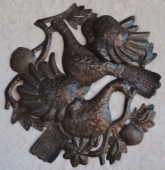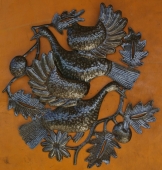The Dove of Peace
When is a dove just a dove? Almost never, it seems. Doves are simple birds that have been heavily endowed with symbolism in cultures that criss-cross time and space. Depending on it’s form, its perceived meaning can change rather profoundly. These, pictured left, are Doves of Peace. Everyone knows it. Everyone I’ve ever heard call it anything has called them Doves of Peace. One hundred percent of the time. But why is that?
The answer is several thousand years old, with the passing of time and events sealing the deal. Back when Noah was sailing on his Ark, desperate for a sign that God’s wrath abated, he sent off a dove in search of land. It took a few tries, but one day, the dove returned with an olive branch in its beak. Noah knew by the olive branch that land had arisen from the flood waters and God was at peace with Mankind once again. This story is, of course, from the Judeo-Christian tradition, but there are other sources as well.
In Central Asia, there is a very old folk tale about two kings who were about to face each other in war in Central Asia. A dove had built a nest in the helmet of one of the kings and the king’s mother implored him not to disturb the nest and leave his helmet at home. The next day, when the two armies marched out to face each other, the king without the helmet rode out to meet the other king. When the second king found out that the first king was without protection because of the dove building a nest in his helmet, he was moved by his compassion and
thought that perhaps he had misjudged him. The two kings talked out their disagreements instead of fighting, and they all lived happily ever after. The dove thus symbolized the peace that was achieved between their two nations. (Hear the story as it is told to children in Azerbaijan here.)
Fast-forward a few milenia to post-war France. Pablo Picasso lived in Nazi-occupied Paris for the duration of World War II and the experience hardened his position as an avowed pacifist. Peace organizations flourished after the War and were eager to engage Picasso and reap the benefits of his celebrity. The First International Peace Congress chose Picasso’s life-like lithograph “La Columbe” as it’s emblem, thus reafirming the dove as a symbol of peace in the modern era. His later renditions of doves were simple line drawings of the bird with a single olive branch in its beak or with colored flowers and an olive branch. These dove drawings became widely associated with the global Peace Movement in the early 1950s and remain among his most popular works today. (See those images here)
And so it is the Dove of Peace. But give it a slight change of form, and it becomes representation of the Holy Spirit. More about that to follow…
First in a series
Contributed by Linda for It’s Cactus


